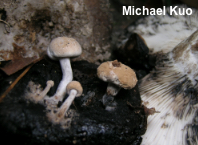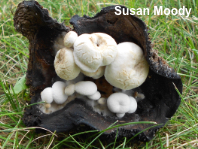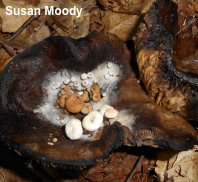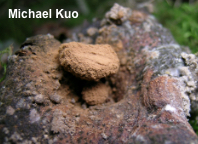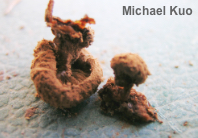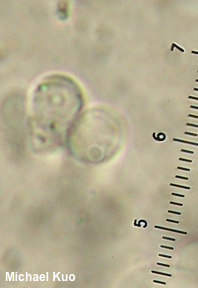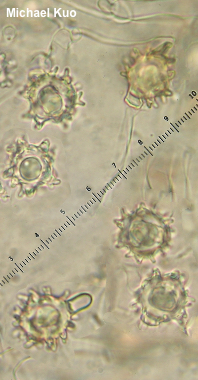| Major Groups > Mycotrophs > Asterophora lycoperdoides |

|
Asterophora lycoperdoides [ Basidiomycota > Agaricales > Lyophyllaceae > Asterophora . . . ] by Michael Kuo This fascinating mushroom is a parasite on other mushrooms—primarily species of blushing russulas like Russula densifolia. It pops right out of the top of its victim, usually when the Russula has blackened and begun to decay. Believe it or not, there are other mushrooms that parasitize russulas and are superficially similar, including species of Collybia and another species of Asterophora, Asterophora parasitica. Among these parasites, Asterophora lycoperdoides is unique in having a cap surface that soon becomes covered with brown powder. See the key to mycotrophs for more help separating these species. The powdery cap of Asterophora lycoperdoides is the result of its aggressive reproductive strategy. Like quaking aspen trees, which hedge their odds by reproducing not only through "normal" sexual means (flowers, seeds, and so on) but also by cloning themselves asexually (saplings arising from root systems), Asterophora lycoperdoides is ready to survive with or without genetic diversity. Its poorly formed gills bear basidia and produce sexual spores—but the cells on the cap surface also produce asexual chlamydospores, ready to clone the organism, resulting in the orangish brown powder that covers everything. Nyctalis asterophora is a former name. Thanks to Sue Moody for documenting, collecting, and preserving Asterophora lycoperdoides for study; her collection is deposited in The Herbarium of Michael Kuo. Description: Ecology: Parasitic on species of Russula and Lactarius (especially Russula dissimulans, Russula densifolia, and closely related blushing russulas); growing alone or gregariously; usually appearing when the victim has begun to blacken and decay; found in a variety of forests since the victims are mycorrhizal with both hardwoods and conifers; summer, fall, and winter (in warmer climates); originally described from France, and found throughout Europe; widely distributed in North America but apparently more common east of the Great Plains; also known from Central America, northern Africa, and Asia. The illustrated and described collections are from Illinois and Minnesota. Cap: 4–20 mm across; convex or nearly round; dry; at first whitish and a little bit roughened or lumpy, becoming covered with dense, orangish brown powder. Gills: Attached to the stem; thick; distant; sometimes poorly formed or vein-like; whitish or grayish; eventually covered with orangish brown powder. Stem: 4–30 mm long; 2–5 mm thick; more or less equal; dry; bald or finely fuzzy; whitish to brownish; eventually covered with orangish brown powder; basal mycelium white. Flesh: White; unchanging when sliced. Odor: Mealy. Microscopic Features: Basidiospores 5–6 x 4–5 µm; ellipsoid; smooth; hyaline in KOH; inamyloid. Basidia 25–28 x 3–6 µm; subclavate; 4-sterigmate. Cystidia not found. Hyphae near the cap surface 3–9 µm wide; walls 0.5 µm thick; smooth; hyaline in KOH; occasionally clamped at septa; contextual hyphae similar but inflated up to 18 µm wide. Chlamydospores 16–20 x 14–17 µm including ornamentation; nodulose-spiny (stellate) but otherwise smooth; hyaline to faintly yellowish in KOH. REFERENCES: (Bulliard, 1784) Ditmar, 1809. (Smith, Smith & Weber, 1979; Phillips, 1981; Arora, 1986; Breitenbach & Kränzlin, 1991; Phillips, 1991/2005; Lincoff, 1992; Horn, Kay & Abel, 1993; Barron, 1999; Roody, 2003; McNeil, 2006; Miller & Miller, 2006; Trudell & Ammirati, 2009; Kuo & Methven, 2010; Uzun et al., 2010; Blanco-Dios, 2011; Buczacki et al., 2012; Hofstetter et al., 2014; Kuo & Methven, 2014; Desjardin, Wood & Stevens, 2015; Siegel & Schwarz, 2016; Baroni, 2017; Gminder & Böhning, 2017; Elliott & Stephenson, 2018; Kalamees, 2018; He et al., 2019; Læssøe & Petersen, 2019.) Herb. Kuo 07310701, 08102001. This site contains no information about the edibility or toxicity of mushrooms. |
© MushroomExpert.Com |
|
Cite this page as: Kuo, M. (2020, October). Asterophora lycoperdoides. Retrieved from the MushroomExpert.Com Web site: http://www.mushroomexpert.com/asterophora_lycoperdoides.html |
